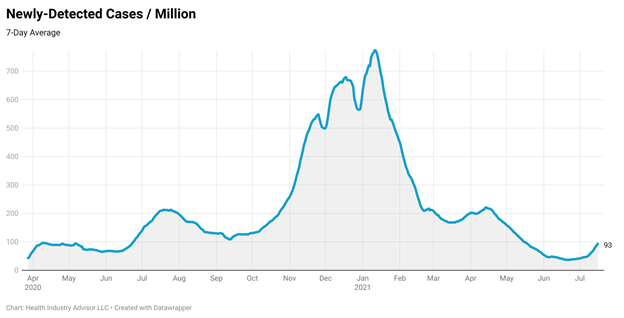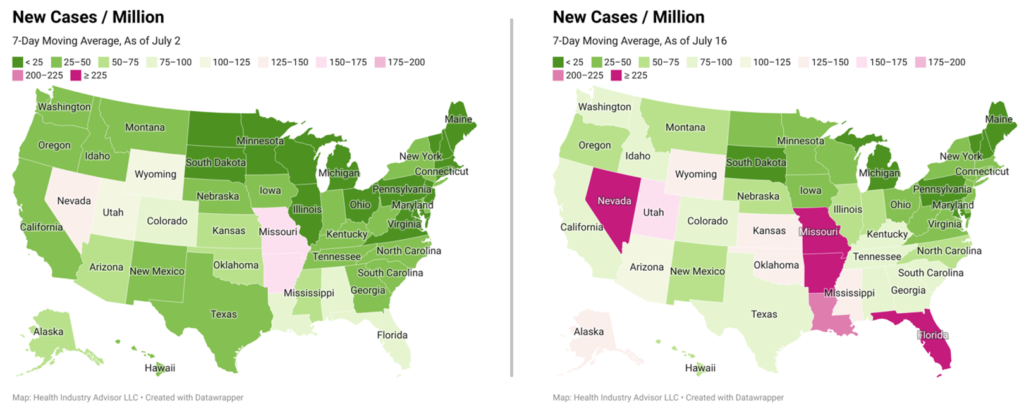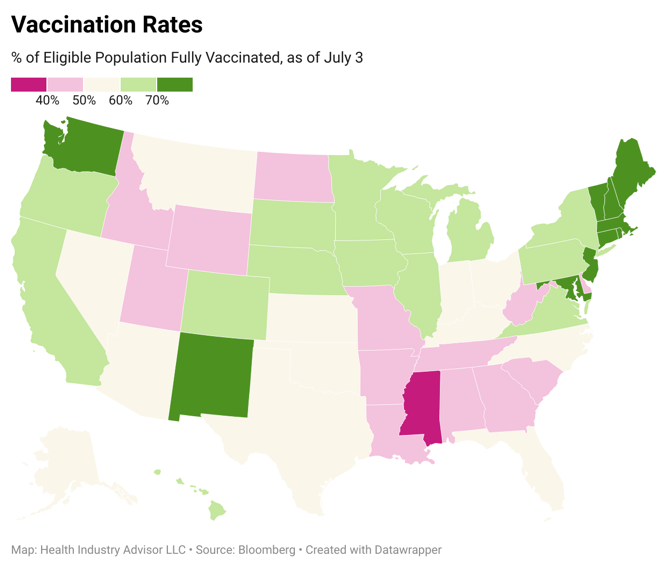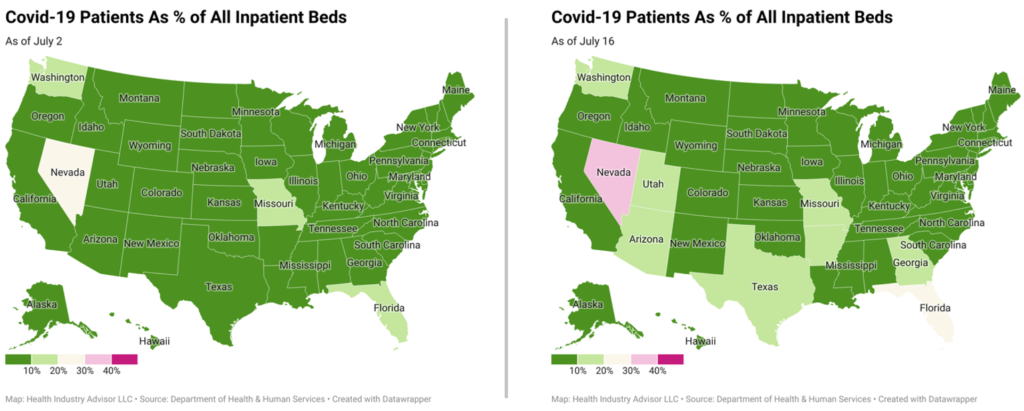July 19, 2021 – Delta variant cases exploded over the past week, with new infections surging 37% week-over-week in the United States and 15% worldwide. Even countries with robust vaccination programs suffered: Israel reported a 77% increase, while the United Kingdom reported a 44% spike.
Still, observers cite the vaccines’ role in limiting the damage: Infection rates are highest among unvaccinated and partially vaccinated persons. Breakthrough cases among those vaccinated appear to be less severe, producing a relatively low hospitalization rate and even lower fatality rate.
The graphic below illustrates the ebb and flow of the virus in the United States since the Spring of 2020. We are witnessing the fifth wave of new infections. Although the infection rate remains low by historical standards, its rise parallels the second wave we encountered last summer. The difference, of course, is that no vaccines were available then to limit the spread and veracity of infections.

So, how does our current experience compare with last summer’s infection wave?
As of last Friday, the United States averaged 93 new infections per million people per day. The country posted a similar rate on June 22, 2020. Case counts were surging last June, as they are today.
Despite the similar infection patterns, there are distinctions in our experience then versus now:
- Case surveillance has improved. In June 2020, nearly 8% of Covid tests were positive. Today, this rate remains under 4%.
- Fewer cases require hospitalization: Covid-19 inpatient census is 15% lower today than last June
- Facility rates have plunged: Last June, an average of 633 people succumbed to the virus each day. Today, the rate is nearly 60% lower.
The vaccines’ role in driving these distinctions is clear: U.S. Surgeon General Vivek Murthy, MD, stated last week that 99.5% of deaths in the U.S. at this time are among unvaccinated persons.
Further, Covid hospitalization rates by age parallel age-based vaccination rates: senior citizens now account for a smaller percentage of hospitalizations than they have at any time during the pandemic. Conversely, persons under 49 – who resist vaccinations in more significant numbers than their elders or aren’t eligible – account for a higher percentage of inpatients than ever. According to the most recent CDC data, nearly half of Covid inpatients are under 50 years of age.
What is Occurring at the State Level?
Infection rates are rising across most of the United States. However, there are pronounced differences between the states in both the intensity and speed of virus spread. Unsurprisingly, we can trace these differences to disparate vaccination rates.
The graphics below highlight the states where the virus is most intense: Missouri, Florida, Arkansas, Nevada, and Louisiana (in descending order of new cases per capita). Except for Nevada, these same states also report the most significant increases in this rate over the past two weeks.

Each of these states lags in fully vaccinating its citizens. Among all states, Florida ranks 28th, Nevada 34th, Missouri 38th, Louisiana 46th, and Arkansas 48th in the percentage of fully vaccinated citizens.

This stands in stark contrast with the experiences of states with high vaccination rates. Vermont has the highest vaccination rate and the second lowest infection rate per capita (one-fifth of the U.S. average). The four states with the next highest vaccination rates and their ranking for infections per capita: Massachusetts (11th lowest infection rate), Maine (9th lowest), Connecticut (12th lowest), and Rhode Island (10th lowest). Infection rates in each of these states were 70% below the U.S. average over the past week.
Given the infection surge in the United States, how are our nation’s hospitals impacted? The charts below illustrate the percentage of inpatient beds occupied by Covid patients. Over the past two weeks, this rate increased from 5.4% to 7.8%. Still, this rate is much lower than the 42% posted back in January.
Hospitalization rates are giving rise to some concern, however, in Nevada and Florida. In Nevada, Covid patients occupy one of every three beds. In Florida, this rate is one in every five. Other states to keep a watchful eye on include Arizona, Arkansas, Georgia, Missouri, Utah, and Washington. Each of these states is devoting at least one of every ten inpatient beds to the treatment of Covid patients.

Summary
The number of new infections last week in Israel, the United Kingdom, and the United States, despite solid vaccination rates, illustrates the virulence of the Delta variant. Studies in each country report some breakthrough cases. Nevertheless, these same studies show that the vaccines provide robust protection against infection, particularly against severe disease.
This column provides corroborating evidence of the vaccines’ effectiveness: states that have achieved strong vaccination rates have fought off the devastating surges caused by the Delta variant. Those states where vaccination programs have lagged are experiencing the brunt of the variant’s impact.
Contributing writer:
Mark A. Van Sumeren, strategic advisor, Medical Devices & Integrated Delivery Networks
Health Industry Advisor LLC, provides a regular report on COVID-19 numbers for the health care industry.
For more information, or to sign up for the report, contact Mark at Mark.VanSumeren@HealthIndustryAdvisor.com; or visit www.HealthIndustryAdvisor.com.
